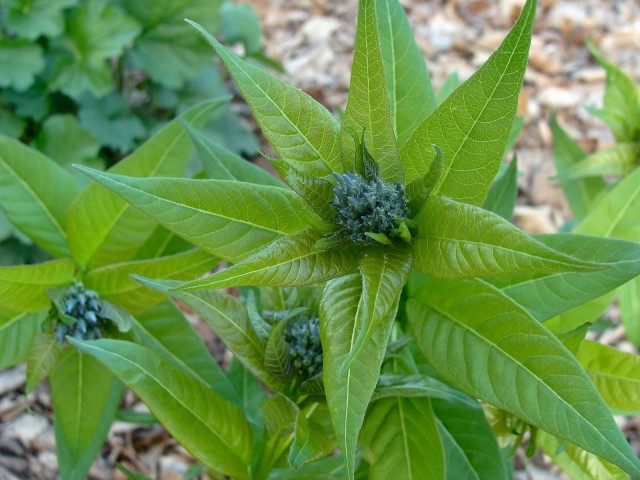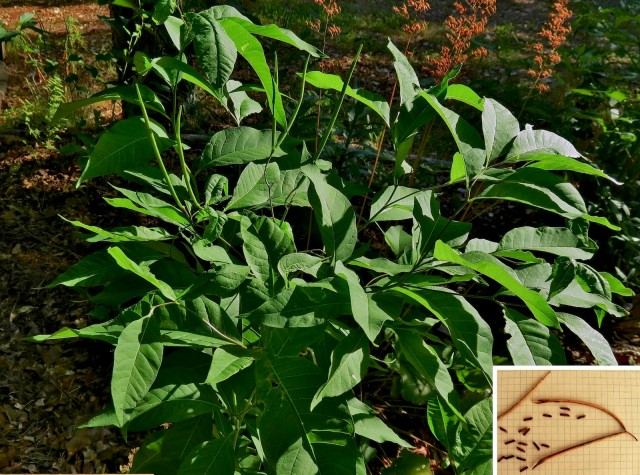Eastern bluestar (Amsonia tabernaemontana) of the Dogbane (Apocynaceae) family is an herbaceous, long-living perennial with blue flowers. The genus name honors 18th-century Virginian physician Dr. Charles Amson. The specific epithet honors Jacob Tabernaemontanus, a 16th-century German physician and botanist and author of the New Herb Book. Other common names include blue dogbane, willowleaf amsonia and woodland bluestar. In the U.S., it occurs naturally from eastern Texas to southeastern Kansas to Illinois and thence southward and eastward to the Atlantic and Gulf Coasts. In Arkansas, it occurs statewide. Eastern bluestar’s preferred habitat is various rocky to loamy well-drained soils in sunny to partially sunny open woodlands, glades and stream banks, as well as moist soils of prairies.
Eastern bluestar may have one to multiple erect stems in early spring. In the case of older multi-stemmed plants, new stems grow from the perimeter of the root clump. Stems grow quickly, with apical clusters of blue, pointed, tightly wound flower buds being apparent shortly after stems emerge. Flowers open as stems grow to a height of about 2 feet. By that time, the inflorescence is at full-bloom, and secondary stems are growing from several upper leaf axils, just below the main inflorescence. These secondary stems angle out and upward from the main stem and soon overtop it, with final plant height to about 2½ feet. Yellow-green, glabrous stems are terete below and ridged above, buttressing the upper leaves that subtend secondary stems and floral branches. Cut stems exude a white (“milky”) sap, characteristic of many members of the dogbane family. Stems arch outward later in the growing season so that plants, especially when heavily fruited, may become twice as wide as tall.
 Photo 1: In early spring, stems of older multi-stemmed plants grow from perimeter of root clump. Apical clusters of tightly wound pubescent blue flower buds are quickly apparent.
Photo 1: In early spring, stems of older multi-stemmed plants grow from perimeter of root clump. Apical clusters of tightly wound pubescent blue flower buds are quickly apparent.
Broadly lanceolate, alternate leaves have blades to 6 inches long and 2½ inches wide. Petioles, to 1 inch long, are slightly winged at base of leaf blade. Leaves are medium green on their upper surface, with a lighter colored mid-vein, while the lower surface is a lighter green. Margins are entire and slightly revolute. Leaves lack pubescence except for hairs along margins (ciliate). Venation, depressed above and expressed below, is offset pinnate with lateral veins arching toward leaf apex and disappearing before reaching leaf margin. Like the stems, cut leaves exude a milky sap.
Flowering period lasts for a month or more in early to mid-spring. Inflorescences, mostly produced at apexes of main stems, consist of several short floral branches of which one terminates the main stem and several others rise from uppermost leaf axils. These floral branches, which are rebranched, each have about a dozen flowers, so that the inflorescence of a single main stem may have a hundred flowers. Some secondary stems, with or without several leaves, may terminate with a floral “branch”. Floral branches typically form ragged clusters that are rounded both radially and across their convex tops. The entire cluster develops simultaneously. Those secondary stems that do not bear flowers become taller than the main stems.
 Photo 2: Upper leaves of these main stems subtend floral branches and secondary stems. Note leaf venation and pubescence of tightly wound flower buds.
Photo 2: Upper leaves of these main stems subtend floral branches and secondary stems. Note leaf venation and pubescence of tightly wound flower buds.
Flowers, to ¾ inch wide, are pale blue overall, with five oblanceolate lobes that form a star-shaped corolla with a whitish center. Corolla lobes join to form a slender floral tube set into a tiny calyx that has five stubby, triangular teeth. Corolla lobes ascend at about 45 degrees from the corolla tube. Entrance to the corolla throat is small and covered with long, white, in-facing, soft hairs (villous pubescence) that extend into the corolla tube. Lobes and tube have a similar length (about 3/8 inch), while the calyx is about 1/16 inch long. The exterior of the corolla tube is a dark blue with a greenish dilated area below. The exterior of the dilated portion of corolla tube is villous.
 Photo 3: Flowers are set in tiny calyxes with greenish dilated corolla tubes, as seen on buds at left. Pale blue flowers have a whitish center with radiating hairs. Secondary stems grow from leaf axils below floral branches.
Photo 3: Flowers are set in tiny calyxes with greenish dilated corolla tubes, as seen on buds at left. Pale blue flowers have a whitish center with radiating hairs. Secondary stems grow from leaf axils below floral branches.
Flowers have an elaborate yet functional structure: a hidden, elongate style is topped by a knob-like stigma. The anthers of five hidden stamens form an incurved, cap-like ring around the stigma. Anthers and stigma are positioned in the dilated section of the tube just below the throat entrance. Staminal filaments arise from the wall of the tube just below the dilated area. Stamens and style are a pale yellow-green while anthers are a light yellow. The single style is attached to the top of two closely appressed but separate ovaries nested in the calyx.
 Photo 4: Flowers have tiny calyxes, styles with knob-like stigmas, and anthers on short filaments. Villous pubescence occurs on exterior and interior of floral tube.
Photo 4: Flowers have tiny calyxes, styles with knob-like stigmas, and anthers on short filaments. Villous pubescence occurs on exterior and interior of floral tube.
With fertilization, the two ovaries of the pistil develop into two fruits, growing into straight to slightly curved, slender, bean-like pods that may be 5 or more inches long. Pods are stiffly erect and tapered to pointed tips. With maturity in early September, each of the brown pods slowly splits from tip to base along a single suture (a fruit technically called a follicle), revealing eight to ten cylindrical, dark brown seeds with slanted ends. The seeds drop to the ground as the pods slowly open. Plants remain leafy and green into fall, when they become a golden-yellow. In winter, persistent stems and papery leaves become light tan to silvery.
 Photo 5: With fertilization, the two ovaries of the pistil separate and lengthen into bean-like pods that may be 5 or more inches long
Photo 5: With fertilization, the two ovaries of the pistil separate and lengthen into bean-like pods that may be 5 or more inches long
 Photo 6: In this early June photo, seed pods are maturing. Brown seed capsules in background are on American alumroot. Inset shows two pods from one flower (the pods still attached to the flower’s pedicel) and seed in September (each square is ¼ inch).
Photo 6: In this early June photo, seed pods are maturing. Brown seed capsules in background are on American alumroot. Inset shows two pods from one flower (the pods still attached to the flower’s pedicel) and seed in September (each square is ¼ inch).
Eastern bluestar is recognized in American Horticultural Society’s 75 Great American Garden Plants as one of the most carefree native wildflowers. It is an ideal plant for partially sunny native plant gardens and natural areas with well drained mesic soils. It returns year after year in early spring as a leafy plant with reliable clusters of blue flowers and attractive foliage throughout the year. Top-heavy plants may be kept more erect by removal of seed pods and/or securing plants to a central stake.
 Photo 6: In this mid-November photo, leaves are an attractive golden-yellow.
Photo 6: In this mid-November photo, leaves are an attractive golden-yellow.
Other species of the genus in Arkansas are: fringed bluestar (Amsonia ciliata var. tenuifolia), Ouachita or Arkansas bluestar (Amsonia hubrichtii), and shining or Ozark bluestar (Amsonia illustris). These three species have flowers similar to those of Amsonia tabernaemontana; however, Amsonia ciliata var. tenuifolia and Amsonia hubrichtii have very narrow, needle-like leaves. Of Arkansas’s bluestars, Amsonia illustris, with its wider leaves, is the most similar to Amsonia tabernaemontana, but Amsonia illustris can be distinguished by its narrower, thicker and shinier leaves, as well as by its drooping seed pods.
Article and photographs by ANPS member Sid Vogelpohl

